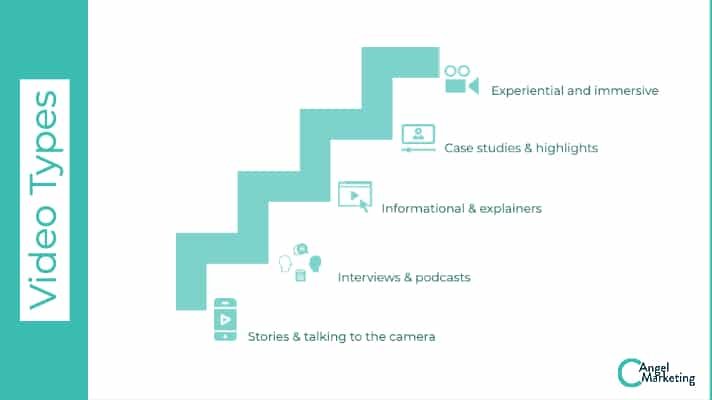About The Nude Window
The Nude Window is a Sunshine Coast-based family business specialising in bespoke curtains and blinds for homes, builders, wholesalers and interior designers. Since starting in 2019, they’ve built a local...
According to Hubspot, 85% of businesses use video marketing as a tool. While Youtube and Facebook remain the most widely used platforms for video, LinkedIn is becoming increasingly popular for B2B companies. Further to that, Instagram video is also growing with the launch of IGTV.
Video is an easy way to explain your business or product, a great way to engage prospective clients and can help build trust with customers.
Video formats on social media allow brands to be seen - according to Later, video gets four times the amount of real estate on the Instagram Explore page than a standard image post. Plus, social channels such as Instagram and Facebook, now have video sections of their app, exclusively for people to watch videos.
The type of video marketing you should use will depend heavily on your business. Software and tech businesses may focus on explainer videos or product demonstrations; service-based businesses may use informational videos on the services they offer. In contrast, hospitality businesses will concentrate on showreel-type videos that showcase their venue.
Further to the type of business you have, you also need to consider your total budget for video marketing. Including the production of the video (is it a 15-second ad, or a 10-minute video), editing (does it need to be professional quality editing) and associated media costs.
If you are running your video marketing campaign across different channels, you will also need to have the video editing to fit the correct video specifications. Horizontal videos that we are used to seeing across channels have now been rivalled with portrait-style videos thanks to the emergence of Snapchat, Tik Tok and Instagram Stories. Chances are you will need to format your video to different lengths and formats depending on what channels you are using.
The below diagram outlines the general types of video you can create relative to budget.

Types of video relative to budget (Diagram based on LinkedIn 2018, How to Stand Out in B2B Video in 2018)
Stories and 'selfie' or 'tripod' style videos are generally low cost. They don't have to be blockbuster quality as they are usually just used for short social media campaigns to stay connected to your audience. These types of videos are generally created and uploaded quickly and at a low cost. Live stories and videos also fall in this category - use these videos to create a sense of urgency with promotions and sales.
Generally, this style of video will involve more than one person. You may want to invest in a microphone (separate to your device microphone) and subtitles if you are distributing via social media.
Informational or educational type videos generally go for more extended periods so that there is time to explain your business, service or product. Sometimes, there is a bit of editing involved to overlay voiceovers, music and snippets of video to get your point across. These types of videos promote your products and services.
Leverage the great things that your current or past clients have to say! Focus on a customer's story and how your business helped to achieve a great outcome. Often with this style of video, you will want to create several versions for different platforms. Videos of current customers using the services or product can really help to build trust and credibility with your target audience.
Highlight the best of your business. Record actual footage of your service or product being implemented and make it exciting. This type of video usually will be a highlight on your website and can be used in several contexts.
There are several ways that you can use your new video. For professional service and consumer-based businesses, videos can be used as a brand awareness tool, a sales tactic and also a way to stay relevant to current customers.
Small to medium businesses should consider what marketing channels they already have available to them to distribute the new video.
The most obvious place for your new video is to highlight it on your website. Depending on the video's purpose you might include it on your homepage, on your 'about us' page in a blog post specific to the topic of your video, the support section or FAQ part of your website or on a customer review page.
Upload the video to your social media channels. Ensure your caption for the video includes a strong Call To Action (CTA).
Youtube video
Facebook post
Instagram IGTV post
Twitter account
Pinterest board
LinkedIn company page
Google My Business video
You should be using email as a communication tool to prospective and current customers. If you are doing monthly newsletters (hint: you should be), consider including a link to the video to get the message out. Likewise, your employees can use the video to engage potential clients but including a link to your website or Youtube channel.
Advertising is the next step to getting the most out of your new video. By using a combination of targeted placements and a professional video, businesses can see fantastic growth in new sales. Depending on the length of the video, several placements are available across different platforms.
Lorem ipsum dolor sit amet consectetur, adipisicing elit. Ipsa libero labore natus atque, ducimus sed.

Small Business, Hospitality, Tips, Customer Experience
Marketing isn’t just about products, services, or clever advertising - it’s about people.
People buy from people.
The strength of relationships in business is what truly drives long-term success, and one of the best examples of...